Bird species of the Hinterland, Park and Bay
Welcome to the fantastic world of birdwatching.
People often ask me what kind of bird species are present in our community grounds and the surrounding Hinterland? Well I can tell you that we have about 45 species that have bred consistently in recent years, 2 more that have bred here in the past and about 22 others that can be seen flying, regularly or occasionally, above the Hinterland but breed elsewhere.
Birds of Gardens and Woodland
Throughout the gardens of the Park there are a considerable number of bird species, many of them colourful and singing beautifully as spring approaches. The most common include: Blue Tit, Coal Tit, Great Tit, Long Tailed Tit (occasionally), Robin, Dunnock, Goldfinch, Chaffinch, Blackbird, Wren, Goldcrest, House Sparrow, and our intelligent and beautiful Magpies. Magpie numbers have increased in numbers thanks to human activity.
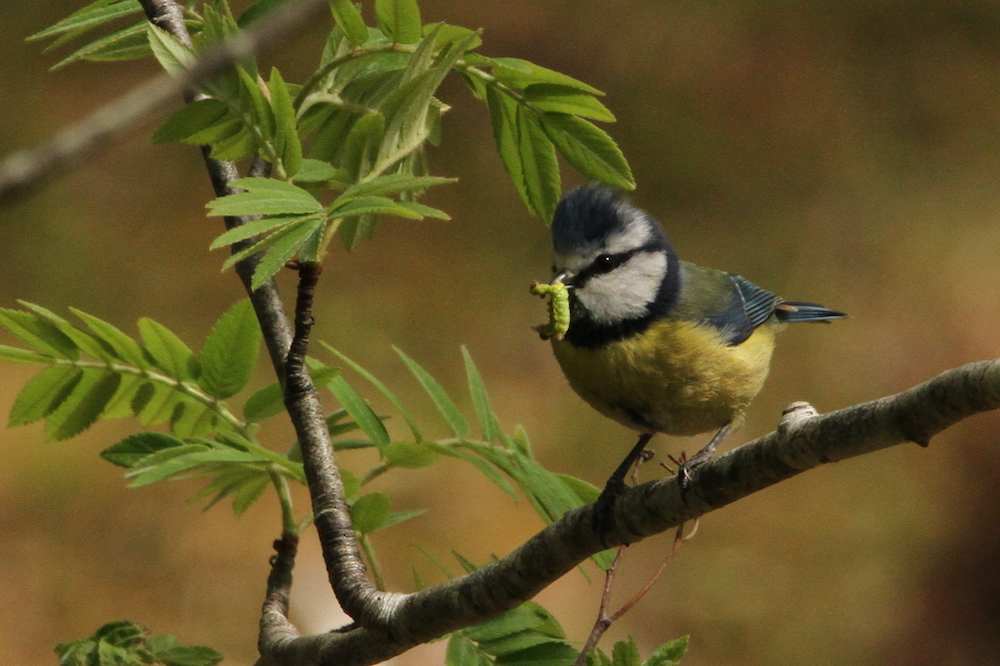
Blue tit (Cyanistes caeruleus) with caterpillar for its young, on the branch of a rowan tree (credit Alan Featherstone)
Almost all of these species present in gardens also reside in the surrounding woodland. Some tend to nest quite high in the trees, such as the Goldcrest, which makes them difficult to see close up, whilst others tend to live quite close to the ground and love to nest inside the piles of brash that we leave behind such as Blackbirds, Robins, Dunnocks and Wrens. Chaffinches come to feed on the ground too but nest high up in the trees. Some of these species like the Dunnock and Wren rarely visit bird feeders so you are less likely to be familiar with them. Others are strictly woodland species like the tiny Goldcrest, the Treecreeper, the shy Bullfinch and the Siskin. Treecreepers are a particularly interesting species that crawl along the trunk of trees just as a mouse might do. We have only a few pairs nesting, mostly in the trees near Bagend.
The Soundtrack of the Hinterland
The most common songs that you hear include the high pitched random songs of the Robin, the watery soft tones of the Blackbird, the high pitched and quick song of the Dunnock, the downward trill of the Chaffinch, the loud repetitive song of the small Wren, or the two-syllable song of the Coal Tit and Great Tit. You will also hear Woodpigeons and Collared Doves singing, and the calls made by Carrion Crows. On certain roofs and tall trees you might also see and hear flocks of Starlings with their amazing vocal repertoire. The dawn chorus heard early each day in March and April is a good time to hear the full orchestra of bird songs.. As spring advances, you will also see the fast flights of Swallows and House Martins, birds that are migratory and only come to Scotland to breed when the weather is warmer.
Birds of Prey
The largest breeding bird of prey is the secretive and fierce Sparrowhawk. It nests in our woodlands, building a large structure high in the trees and hunts many species of birds including pigeons which are its favourite prey – if you see a bird plucking a pigeon it is very likely to be a sparrowhawk. Birds of prey are prone to human persecution which is why I will not disclose their nest sites although in the summer their chick’s begging calls for food help locate where they are. The rest of the time these birds tend to keep silent and hidden so that they can attack by stealth.
Besides the Sparrowhawk, two species of Owl have nested in the Hinterland in recent years: the more common Tawny Owl, and the more elusive Long Eared Owl, which gave birth to a small family last year, and is featured in an article linked here.
Birds of the Open Areas near the Wind Turbines
In the grasslands and dune heath, one finds farmland species like the Greenfinch and the Song Thrush. The real stars are the Yellowhammer and the Linnet. Both species are red-listed, meaning they are in serious decline in the UK. The Yellowhammer is a distinctive yellow bird that sings a song that sounds like the sentence “a little bit of bread and no cheese”. Each year there are about 8-12 territories occupied by pairs of yellowhammers. The Linnet forms larger flocks above the gorse and has a more subtle melodic song. These red-listed species are threatened by loss of dune heath and grassland habitats which are becoming increasingly rare in the UK. The Trust manages these special habitats in its care so that they do not revert to pine forest in the future.
In spring you will also stumble upon two migrant species singing in the area, the Willow Warbler (quite widespread across the open shrubby areas) and the Chiffchaff (usually higher up in taller trees, singing a metronomic song “chiff, chaff, chiff, chaff, chiff, chaff).
Common species like Wren, Robin, Dunnock, Blackbird, Wood Pigeon and Carrion Crow are also widespread in the open areas near the wind turbines. If you think it’s too many species by now, then we should walk together and I would be happy to point out these birds to you.
Further out in the dunes, one can also find species like the Stonechat, Lesser Redpoll, Meadow Pipit, Skylark and Sand Martins. Sand Martins are the birds that form a colony in the faces of the sand cliffs at the beach. Finally, Pheasants are a common bird in the area. They are an introduced species (and the only game bird species in the Hinterland, as there are no Red Grouse, nor Grey Partridge in the area).
Common species like Wren, Robin, Dunnock, Blackbird, Wood Pigeon and Carrion Crow are also widespread in the open areas near the wind turbines. Herring Gulls are very common, and Rooks can be seen too. If you think it’s too many species by now, then we should walk together and I would be happy to point out these birds to you.
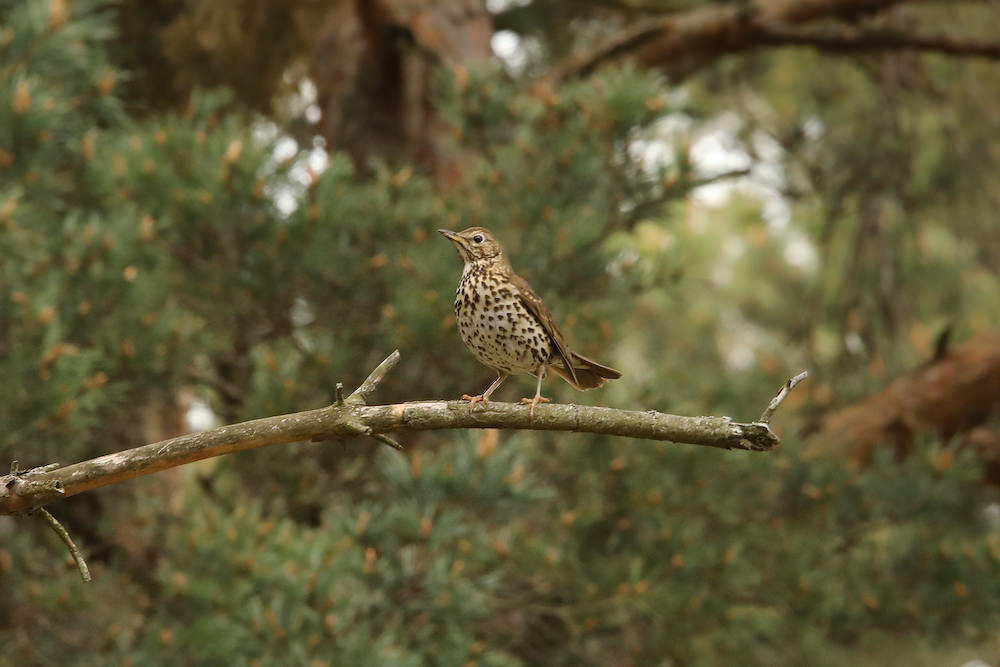
Song thrush (Turdus philomelos) on the branch of a Scots pine (credit Alan Featherstone)
Rarer birds
Of the 45 breeding species, 6 have a currently unconfirmed breeding status (meaning we do not know if they have nested and bred fledglings), because of their very low population in the Hinterland. Most of these species are red-listed in the UK. Mistle Thrush are seen occasionally, and numbers vary from year to year. The species needs grasslands that harbour a good number of invertebrates like snails. Our pony field attracts them as well as Cullerne garden. The Spotted Flycatcher is a scarce species seen in summer but numbers are declining (the species prefer moist habitats which are rich in insects). Maybe our ponds are helping to attract the species. The Crossbill is an iconic Scottish species. They are big, orangy birds with huge bills to rip apart pine cones. I know when they fly above the trees because of their unique piping calls. Another iconic bird species is the Crested Tit, a sort of punk rock hairstyle sort of bird. It is restricted to the NE of Scotland and we suspected that we had 2 pairs nesting in the Hinterland last year. Cuckoos are scarce and an irregular visitor. One pair seems to have bred in 2020 near the wind turbines but no pair was seen in 2021. The Whitethroat is another scarce species, present on the dune heath.
Other bird species
Two birds of prey have bred in the past but not in recent years. The Kestrel is a small falcon that used to be common in the Hinterland dunes, but it’s now absent, probably because of rodenticide use (which is the most common cause of fatalities for this bird). This species still breeds at the Bay. The legally protected Barn Owl, which is a beautiful white ghost-like species of owl, used to nest in the Hinterland, but not recently. It still very occasionally visits our grassland areas. Other bird species are seen more rarely, such as Lapwings and birds of prey that occasionally visit our lands such as Peregrine, Red Kite, Short Eared Owl and Merlin.
I counted 22 more species that can be seen flying above the Hinterland, some regularly and some only occasionally. Common Terns and Sandwich Terns are often seen and heard during the summer, and Curlews are regularly seen flying above the Pony’s field. Curlews need areas of tall and moist grassland, so the Hinterland is too dry for them. They breed by the Bay and the species has sparked serious conservation efforts due to its long-term decline in numbers. Grey Heron occasionally visits our woodland (and even some gardens!), and Woodcock also visits the woodland occasionally in winter. Other species can be seen flying regularly, like Mallard duck and Shelduck (that breed at the Bay), Pink Footed Geese (which breed in Iceland), and raptors like Osprey and Buzzard (that occasionally fly above our community grounds). Other bird species are seen more rarely. In winter, the Hinterland also receives some winter visitor species, such as Redwing, Fieldfare, Brambling, and Waxwing (rarely).”
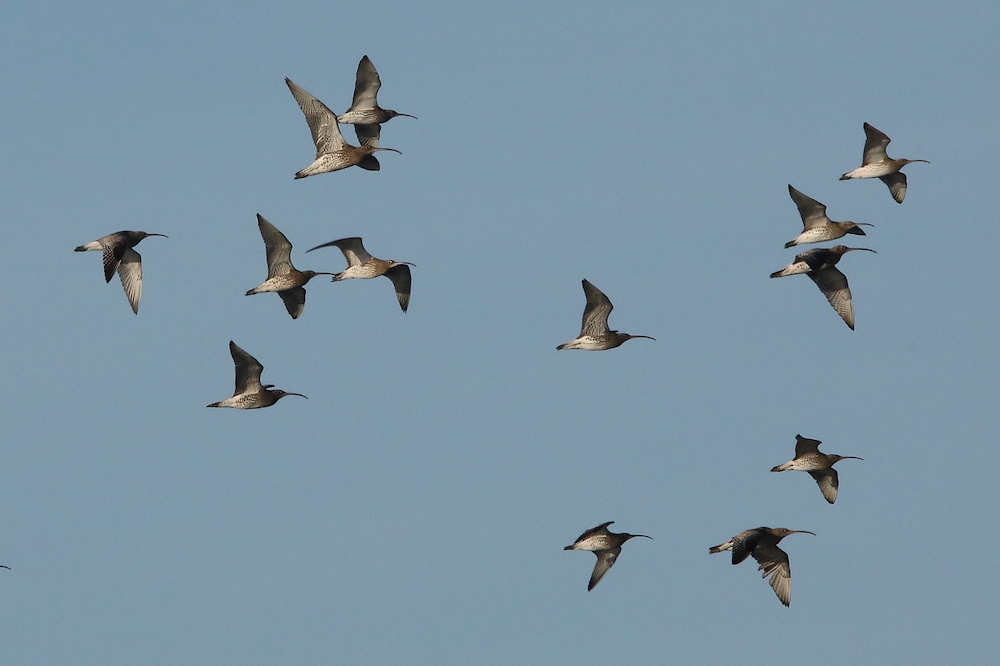
Flock of curlews (Numenius arquata) in flight (credit Alan Featherstone)
Other birds / Surroundings
Although not part of the Hinterland, we live next to another bird haven. The Findhorn Bay presents an opportunity to see waders (birds that wade through the tidal muds hunting for invertebrates with their very long bills) like Oystercatchers, Redshank, Curlew, Dunlin, Knot, Bar–tailed Godwits, and also several Gull and Duck species, and in summer, the majestic sight of Ospreys hunting fish. Pied Wagtail is commonly seen at the edges of the bay. Gull species include Herring Gull, Common Gull and Black Headed Gull.
Bird Boxes
We have 6 bird boxes and 3 bat boxes on the south side of Wilkies Wood near Soillse and the pond, on the way to the Pony field, and 2 other boxes in the northern side of that woodland. We also have 4 bird boxes on the northern side of the Corsican Pine woodland near Pineridge and 3 boxes just next to the new Conservation Hub – about 20 boxes in total.
Every winter, we clean the Hinterland bird boxes. This year, John Willoner and I met a few times (usually in glorious sunshine weather) and we used a ladder to get up in the trees, bring the boxes down, open them, clean them, and then return them back to the trees. Our bird boxes have many different designs and therefore can be host to different species (Blue tits, great tits, robin, flycatchers, etc). In Wilkies Wood we found a blue tit nest in one of the bird boxes (a nest from spring 2021), as last year I monitored each box and I knew that a pair of blue tits nested inside that box and gave birth to 3 fledglings. I also found a dead magpie inside a large bird box. I wasn’t sure exactly why the bird died but it was a juvenile. I also found a dead magpie inside a large bird box. I wasn’t sure exactly why the bird died but it was a juvenile. Some of our bird boxes have also been damaged by Great Spotted Woodpeckers, which “drill” holes into the boxes. We have taken inventive measures to prevent that from happening.
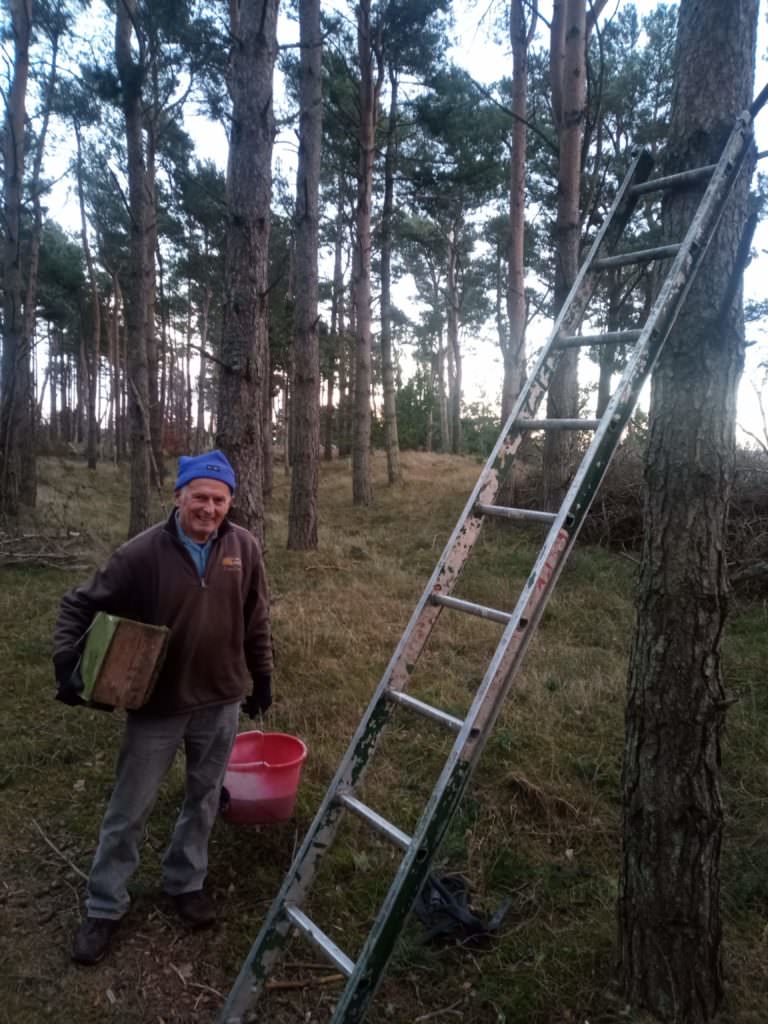
John Willoner installed bird boxes at the Hinterland, in February 2022 (credit Paulo Bessa)
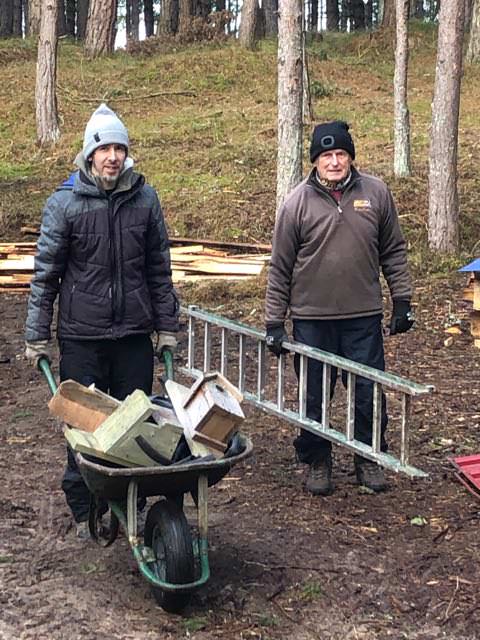
John Willoner and Paulo Bessa preparing to install bird boxes at the Hinterland, in February 2022 (credit Jonathan Caddy)
Surveying birds
Every spring I also survey the birds of the Hinterland. This is not as complicated as you might think. The surveys are done by two very early walks in April and June, when I record the birds seen and heard, along defined transects (lines across the area). So basically it is a walk listening/ seeing/ counting birds. When I do that, I record the distance where I see each bird, and their behaviour. This way we are able to know how many breeding pairs of each species are present on the land, and know any variation from year to year that might be the result of our conservation or other activities.
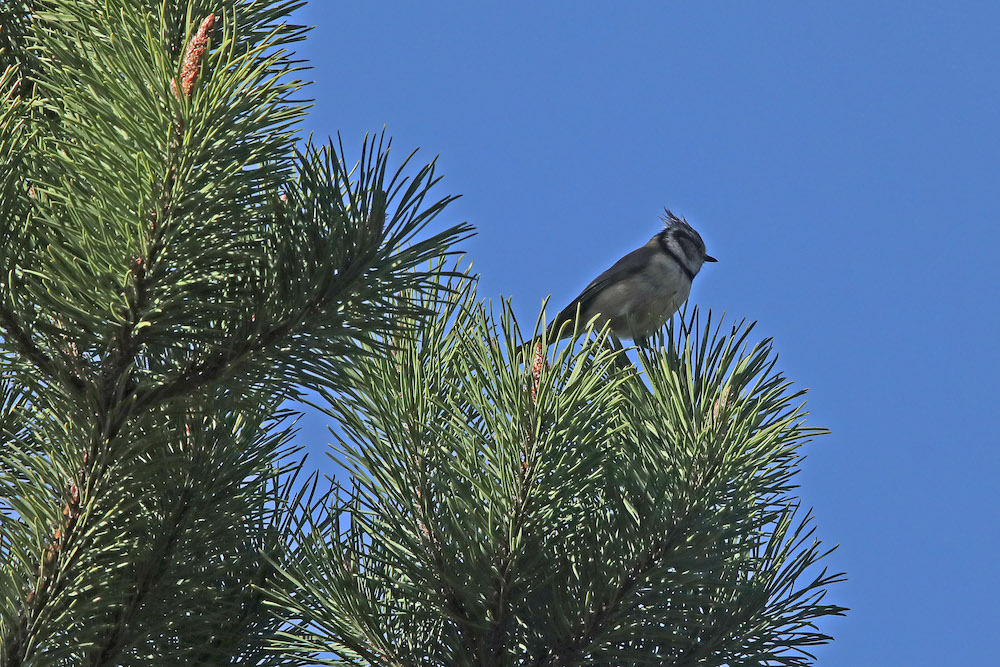
Crested tit (Lophophanes cristatus) on a lodgepole pine (credit Alan Featherstone)
I hope that you have enjoyed this detailed journey into the birdlife of our community lands. Take your time to appreciate the birdlife when you walk outside during these spring months. Their songs delight us year after year, remind us of the beauty of nature and are synonymous with warmer weather and brighter moods.

















Birds of the Hinterland
Bird species of the Hinterland, Park and Bay
Welcome to the fantastic world of birdwatching.
People often ask me what kind of bird species are present in our community grounds and the surrounding Hinterland? Well I can tell you that we have about 45 species that have bred consistently in recent years, 2 more that have bred here in the past and about 22 others that can be seen flying, regularly or occasionally, above the Hinterland but breed elsewhere.
Birds of Gardens and Woodland
Throughout the gardens of the Park there are a considerable number of bird species, many of them colourful and singing beautifully as spring approaches. The most common include: Blue Tit, Coal Tit, Great Tit, Long Tailed Tit (occasionally), Robin, Dunnock, Goldfinch, Chaffinch, Blackbird, Wren, Goldcrest, House Sparrow, and our intelligent and beautiful Magpies. Magpie numbers have increased in numbers thanks to human activity.
Blue tit (Cyanistes caeruleus) with caterpillar for its young, on the branch of a rowan tree (credit Alan Featherstone)
Almost all of these species present in gardens also reside in the surrounding woodland. Some tend to nest quite high in the trees, such as the Goldcrest, which makes them difficult to see close up, whilst others tend to live quite close to the ground and love to nest inside the piles of brash that we leave behind such as Blackbirds, Robins, Dunnocks and Wrens. Chaffinches come to feed on the ground too but nest high up in the trees. Some of these species like the Dunnock and Wren rarely visit bird feeders so you are less likely to be familiar with them. Others are strictly woodland species like the tiny Goldcrest, the Treecreeper, the shy Bullfinch and the Siskin. Treecreepers are a particularly interesting species that crawl along the trunk of trees just as a mouse might do. We have only a few pairs nesting, mostly in the trees near Bagend.
The Soundtrack of the Hinterland
The most common songs that you hear include the high pitched random songs of the Robin, the watery soft tones of the Blackbird, the high pitched and quick song of the Dunnock, the downward trill of the Chaffinch, the loud repetitive song of the small Wren, or the two-syllable song of the Coal Tit and Great Tit. You will also hear Woodpigeons and Collared Doves singing, and the calls made by Carrion Crows. On certain roofs and tall trees you might also see and hear flocks of Starlings with their amazing vocal repertoire. The dawn chorus heard early each day in March and April is a good time to hear the full orchestra of bird songs.. As spring advances, you will also see the fast flights of Swallows and House Martins, birds that are migratory and only come to Scotland to breed when the weather is warmer.
Birds of Prey
The largest breeding bird of prey is the secretive and fierce Sparrowhawk. It nests in our woodlands, building a large structure high in the trees and hunts many species of birds including pigeons which are its favourite prey – if you see a bird plucking a pigeon it is very likely to be a sparrowhawk. Birds of prey are prone to human persecution which is why I will not disclose their nest sites although in the summer their chick’s begging calls for food help locate where they are. The rest of the time these birds tend to keep silent and hidden so that they can attack by stealth.
Besides the Sparrowhawk, two species of Owl have nested in the Hinterland in recent years: the more common Tawny Owl, and the more elusive Long Eared Owl, which gave birth to a small family last year, and is featured in an article linked here.
Birds of the Open Areas near the Wind Turbines
In the grasslands and dune heath, one finds farmland species like the Greenfinch and the Song Thrush. The real stars are the Yellowhammer and the Linnet. Both species are red-listed, meaning they are in serious decline in the UK. The Yellowhammer is a distinctive yellow bird that sings a song that sounds like the sentence “a little bit of bread and no cheese”. Each year there are about 8-12 territories occupied by pairs of yellowhammers. The Linnet forms larger flocks above the gorse and has a more subtle melodic song. These red-listed species are threatened by loss of dune heath and grassland habitats which are becoming increasingly rare in the UK. The Trust manages these special habitats in its care so that they do not revert to pine forest in the future.
In spring you will also stumble upon two migrant species singing in the area, the Willow Warbler (quite widespread across the open shrubby areas) and the Chiffchaff (usually higher up in taller trees, singing a metronomic song “chiff, chaff, chiff, chaff, chiff, chaff).
Common species like Wren, Robin, Dunnock, Blackbird, Wood Pigeon and Carrion Crow are also widespread in the open areas near the wind turbines. If you think it’s too many species by now, then we should walk together and I would be happy to point out these birds to you.
Further out in the dunes, one can also find species like the Stonechat, Lesser Redpoll, Meadow Pipit, Skylark and Sand Martins. Sand Martins are the birds that form a colony in the faces of the sand cliffs at the beach. Finally, Pheasants are a common bird in the area. They are an introduced species (and the only game bird species in the Hinterland, as there are no Red Grouse, nor Grey Partridge in the area).
Common species like Wren, Robin, Dunnock, Blackbird, Wood Pigeon and Carrion Crow are also widespread in the open areas near the wind turbines. Herring Gulls are very common, and Rooks can be seen too. If you think it’s too many species by now, then we should walk together and I would be happy to point out these birds to you.
Song thrush (Turdus philomelos) on the branch of a Scots pine (credit Alan Featherstone)
Rarer birds
Of the 45 breeding species, 6 have a currently unconfirmed breeding status (meaning we do not know if they have nested and bred fledglings), because of their very low population in the Hinterland. Most of these species are red-listed in the UK. Mistle Thrush are seen occasionally, and numbers vary from year to year. The species needs grasslands that harbour a good number of invertebrates like snails. Our pony field attracts them as well as Cullerne garden. The Spotted Flycatcher is a scarce species seen in summer but numbers are declining (the species prefer moist habitats which are rich in insects). Maybe our ponds are helping to attract the species. The Crossbill is an iconic Scottish species. They are big, orangy birds with huge bills to rip apart pine cones. I know when they fly above the trees because of their unique piping calls. Another iconic bird species is the Crested Tit, a sort of punk rock hairstyle sort of bird. It is restricted to the NE of Scotland and we suspected that we had 2 pairs nesting in the Hinterland last year. Cuckoos are scarce and an irregular visitor. One pair seems to have bred in 2020 near the wind turbines but no pair was seen in 2021. The Whitethroat is another scarce species, present on the dune heath.
Other bird species
Two birds of prey have bred in the past but not in recent years. The Kestrel is a small falcon that used to be common in the Hinterland dunes, but it’s now absent, probably because of rodenticide use (which is the most common cause of fatalities for this bird). This species still breeds at the Bay. The legally protected Barn Owl, which is a beautiful white ghost-like species of owl, used to nest in the Hinterland, but not recently. It still very occasionally visits our grassland areas. Other bird species are seen more rarely, such as Lapwings and birds of prey that occasionally visit our lands such as Peregrine, Red Kite, Short Eared Owl and Merlin.
I counted 22 more species that can be seen flying above the Hinterland, some regularly and some only occasionally. Common Terns and Sandwich Terns are often seen and heard during the summer, and Curlews are regularly seen flying above the Pony’s field. Curlews need areas of tall and moist grassland, so the Hinterland is too dry for them. They breed by the Bay and the species has sparked serious conservation efforts due to its long-term decline in numbers. Grey Heron occasionally visits our woodland (and even some gardens!), and Woodcock also visits the woodland occasionally in winter. Other species can be seen flying regularly, like Mallard duck and Shelduck (that breed at the Bay), Pink Footed Geese (which breed in Iceland), and raptors like Osprey and Buzzard (that occasionally fly above our community grounds). Other bird species are seen more rarely. In winter, the Hinterland also receives some winter visitor species, such as Redwing, Fieldfare, Brambling, and Waxwing (rarely).”
Flock of curlews (Numenius arquata) in flight (credit Alan Featherstone)
Other birds / Surroundings
Although not part of the Hinterland, we live next to another bird haven. The Findhorn Bay presents an opportunity to see waders (birds that wade through the tidal muds hunting for invertebrates with their very long bills) like Oystercatchers, Redshank, Curlew, Dunlin, Knot, Bar–tail
Bird Boxes
We have 6 bird boxes and 3 bat boxes on the south side of Wilkies Wood near Soillse and the pond, on the way to the Pony field, and 2 other boxes in the northern side of that woodland. We also have 4 bird boxes on the northern side of the Corsican Pine woodland near Pineridge and 3 boxes just next to the new Conservation Hub – about 20 boxes in total.
Every winter, we clean the Hinterland bird boxes. This year, John Willoner and I met a few times (usually in glorious sunshine weather) and we used a ladder to get up in the trees, bring the boxes down, open them, clean them, and then return them back to the trees. Our bird boxes have many different designs and therefore can be host to different species (Blue tits, great tits, robin, flycatchers, etc). In Wilkies Wood we found a blue tit nest in one of the bird boxes (a nest from spring 2021), as last year I monitored each box and I knew that a pair of blue tits nested inside that box and gave birth to 3 fledglings. I also found a dead magpie inside a large bird box. I wasn’t sure exactly why the bird died but it was a juvenile. I also found a dead magpie inside a large bird box. I wasn’t sure exactly why the bird died but it was a juvenile. Some of our bird boxes have also been damaged by Great Spotted Woodpeckers, which “drill” holes into the boxes. We have taken inventive measures to prevent that from happening.
John Willoner installed bird boxes at the Hinterland, in February 2022 (credit Paulo Bessa)
John Willoner and Paulo Bessa preparing to install bird boxes at the Hinterland, in February 2022 (credit Jonathan Caddy)
Surveying birds
Every spring I also survey the birds of the Hinterland. This is not as complicated as you might think. The surveys are done by two very early walks in April and June, when I record the birds seen and heard, along defined transects (lines across the area). So basically it is a walk listening/ seeing/ counting birds. When I do that, I record the distance where I see each bird, and their behaviour. This way we are able to know how many breeding pairs of each species are present on the land, and know any variation from year to year that might be the result of our conservation or other activities.
Crested tit (Lophophanes cristatus) on a lodgepole pine (credit Alan Featherstone)
I hope that you have enjoyed this detailed journey into the birdlife of our community lands. Take your time to appreciate the birdlife when you walk outside during these spring months. Their songs delight us year after year, remind us of the beauty of nature and are synonymous with warmer weather and brighter moods.